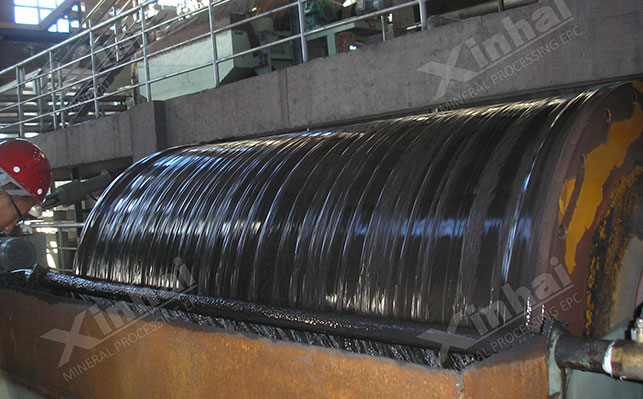
15311826613
Click to add WeChatManganese is used in many fields such as metallurgy, machinery, and fire protection. There are two common types of manganese ore, one is manganese oxide, and the other is manganese carbonate. Manganese carbonate is the main source of manganese, but after years of mining, the easy-to-select manganese carbonate is becoming less and less, and most of them are difficult-to-select manganese carbonate with embedded particle size. In addition, manganese carbonate has a high content of calcium and magnesium carbonate, and the embedded relationship between manganese minerals and other gangue minerals is complex. There are many types of minerals, and the ore is easy to muddy, making it difficult to select.
Currently, the commonly used manganese carbonate beneficiation methods include ore washing, gravity separation, magnetic separation, flotation and leaching. Let's learn about them together!
Ore washing refers to the process of removing the ore mud on the surface of the ore under the action of hydraulic or mechanical force. Most of them are used as preparatory work before crushing or separation. Its main purpose is to improve the grade of the selected lump ore and reduce the impact of ore mud on subsequent operations. Manganese carbonate ore is brittle and easy to mud and coexists with clay minerals, so it is necessary to wash the ore first to improve the ore grade.

Commonly used washing equipment in manganese carbonate beneficiation plants include hydraulic washing screen, vibrating screen, cylindrical washing machine and trough washing machine, etc.
Gravity separation is a technical means of separation by density based on the different density of mineral particles and different falling speeds in the medium. Generally, manganese carbonate minerals have a large density, while the density of the gangue minerals associated with them is small, which can be separated by gravity separation. But sometimes, a single gravity separation process cannot obtain satisfactory separation indicators, and it is often used in combination with other processes, such as gravity separation-magnetic separation, gravity separation-flotation separation, etc.

The gravity separation equipment commonly used in manganese carbonate concentrators mainly includes heavy medium separators, shaking tables, jigging, chutes, cyclones and centrifuges.
Manganese carbonate ore is a weakly magnetic mineral, and most of the associated gangue is non-magnetic silicate minerals. Therefore, strong magnetic separation is an important means of separating and enriching manganese carbonate. Magnetic separation occupies a small area and has low energy consumption. It is a low-cost beneficiation method, and the magnetic separation process is economical and environmentally friendly. Magnetic separation is widely used in manganese carbonate beneficiation, but it is restricted by the environment, its scope of action is limited, and it is not suitable for processing fine-grained manganese carbonate minerals.

Commonly used magnetic separation equipment in manganese carbonate beneficiation plants include dry magnetic separators, wet magnetic separators, and high gradient magnetic separators.
Manganese carbonate ore is associated with more gangue, with complex composition and finer particle size. The advantages of flotation method in treating fine manganese carbonate ore are high enrichment efficiency and strong adaptability; the disadvantages are high cost investment, easy to cause environmental pollution, and high process parameter requirements. Generally, positive flotation is used to treat manganese carbonate ore, and combined reagents are mostly used for separation.

Commonly used flotation equipment in manganese carbonate beneficiation plants include two types: aerated stirring flotation machine and mechanical stirring flotation machine. The former equipment includes XCF type flotation machine and KYF type flotation machine; the latter includes SF type, JJF type and BF type.
The leaching method mainly changes the properties of mineral materials by chemical means, thereby comprehensively recycling the minerals. Leaching methods mainly include pre-roasting leaching, direct acid leaching and microbial leaching.
Pre-roasting leaching: It is mainly aimed at the recovery of high-priced manganese resources. The principle is to reduce high-priced manganese to low-priced manganese, so that manganese elements can be recovered in the form of manganese ions during the leaching process;
Direct acid leaching: It is a process of directly applying acid to manganese carbonate ore to leach manganese, but attention should be paid to the influence of various conditions (reaction temperature, liquid-solid ratio, leaching time, stirring intensity, etc.) during the leaching process;
Microbial leaching: It adopts bacterial leaching method, which uses bacteria to directly or indirectly act on the target mineral components, thereby improving the recovery effect of the target mineral.
The above is an introduction to the commonly used beneficiation methods for manganese carbonate. However, as manganese carbonate becomes more and more refined and difficult to beneficiate, a single beneficiation method can no longer meet the beneficiation conditions of manganese carbonate. Therefore, a combined method is often used for separation. How to choose and use the combined process depends on the properties of the manganese carbonate ore. The beneficiation test analysis should be carried out first. By analyzing and designing a suitable manganese carbonate beneficiation process, an ideal return on investment has been achieved and qualified manganese carbonate concentrate has been obtained.